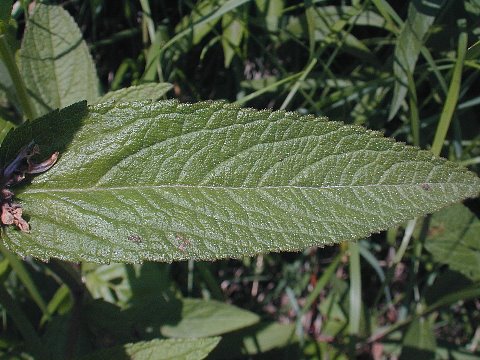Description: This perennial plant is about 1½-3' tall and either unbranched or sparingly so. The 4-angled central stem is light green to dark purple and covered with fine hairs on all sides. The opposite leaves are up to 4" long and 1¾" across. They are lanceolate-oblong to ovate-oblong in shape, finely serrated along their margins, and either sessile against the stem or with short petioles (less than 1/3" or 8 mm. in length). The upper leaf surface is medium to dark green and finely short-hairy, while the lower surface is light green and finely hairy, especially along the lower sides of major veins. The foliage has an unpleasant bitter smell. The central stem terminates in a spike of flowers about 4-8" long. This spike consists of about 4-12 whorls of flowers, each whorl having several flowers. Each flower is about ½" long, consisting of a short-tubular corolla with 2 lips, a short-tubular calyx with 5 narrow triangular teeth, and the inserted reproductive organs. The corolla is white to light pink with splotches of rosy pink. The upper lip of the corolla is undivided and hairy along its upper surface, while the lower lip is divided into 3 lobes (a central lobe and 2 smaller side lobes). The calyx is green to purplish green and finely hairy. The calyx is green or purplish green; its teeth extend to more than one-half of the length of the corolla tube (excluding the length of the lips). The central stalk of the floral spike is green to dark purple and covered with fine hairs on all sides. The blooming period occurs during the summer and lasts about 1-2 months. Sometimes the flowers have a mild fragrance.

After the blooming period, the flowers are replaced by
open seed capsules; each capsule contains 4 small nutlets. The root
system
is rhizomatous and tuberous. Hairy Hedge Nettle often forms clonal
colonies of varying size.
Cultivation:
The preference is full sun to light shade, moist conditions, and soil
that is loamy or sandy. The foliage is rarely bothered by either
disease or insects.
Range & Habitat:
The native Hairy Hedge Nettle occurs primarily in central and northern
Illinois, where it is occasional. In southern Illinois, it is either
absent or uncommon (see Distribution
Map). Habitats include moist
prairies, edges of marshes,
moist meadows in wooded areas, borders of bottomland woodlands, soggy
thickets, prairie swales, roadside ditches, edges of fields,
and
fence rows. Hairy Hedge Nettle can occur in either sandy or non-sandy
habitats that are variable in their level of disturbance.

Faunal
Associations:
The flowers are visited by nectar-seeking bees primarily, including
bumblebees, leaf-cutting bees (Megachile
spp.), digger bees (Melissodes
spp.), little carpenter bees (Ceratina spp.), and
Anthophorid bees (Anthophora
spp.).
Sometimes the flowers are visited by butterflies, skippers, and moths,
but they are not very effective at cross-pollination. Small bees also
visit the flowers to collect pollen. The seeds of Stachys spp. (Hedge
Nettles) and other members of the Mint family are eaten by Sehirus cinctus
(White-Margined Burrower Bug). Because the foliage is bitter and hairy,
it is not favored as a food source by mammalian herbivores.
Photographic Location:
The photograph was taken in an overgrown moist area between an
abandoned railroad and a
roadside in Champaign County, Illinois.

Comments: This plant has an unsettled taxonomic history. At the present time, I prefer to use the scientific name Stachys palustris arenicola from the Field Guide to Indiana Wildflowers (2000) by Kay Yatskievych. Older authorities, such as A. G. Jones or Britton & Brown, called this species Stachys arenicola. In contrast, Mohlenbrock (1986, 2002) probably refers to this species as a variety of Stachys palustris or Stachys pilosa. Hairy Hedge Nettle can be distinguished from other Stachys spp. (Hedge Nettles) by the presence of fine hairs on all 4 sides of its central stem, the general hairiness of its leaves, the absence of petioles exceeding 1/3" (8 mm.) in length, the length of its toothed calyx in relation to the corolla tube (exceeding one-half of its length), and the shape of its calyx teeth. All of the Hedge Nettles differ from the similar Teucrium canadense (American Germander) by having flowers with well-defined upper lips.